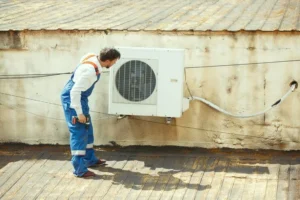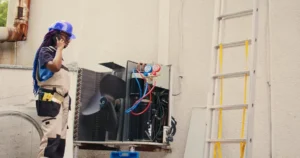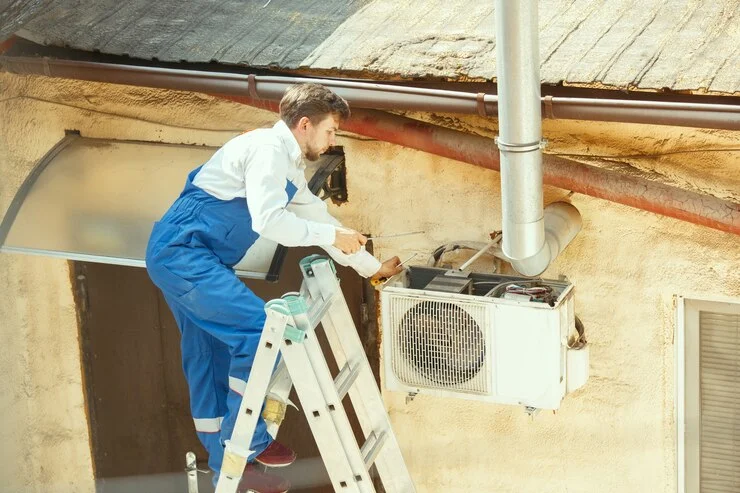Air conditioning can be a lifesaver during hot and humid days, but setting the right temperature goes beyond just comfort. Finding the ideal temperature balance is essential to maximizing energy efficiency, extending the life of your unit, and keeping electricity costs in check. But how do you determine that “perfect” temperature for your space?
In this guide, we’ll explore the optimal temperature settings for your air conditioning, share energy-saving tips, and discuss the role of regular maintenance.
Why Temperature Setting Matters
The temperature you set for your air conditioner impacts more than just your comfort; it affects energy consumption, indoor air quality, and even your AC’s longevity. Overcooling or continuously fluctuating the thermostat can place unnecessary strain on your air conditioner, leading to potential malfunctions and increased repair needs. For guidance on maintaining your AC unit, seeking professional help from the best air condition repair services in Kolkata can help identify and resolve issues before they worsen.
Optimal Temperature Settings: The Sweet Spot for Comfort and Efficiency
For general comfort and maximum energy efficiency, most experts recommend setting your thermostat to around 24-26°C (75-78°F) when you’re home. During warmer months, maintaining this range provides a comfortable indoor environment without overworking the AC.
Here’s a breakdown of temperature recommendations based on different scenarios:
- During Daytime (When Home): 24-26°C (75-78°F)
- At Night (For Sleep): 25°C (77°F) to prevent overcooling while allowing rest
- Away from Home: 28-30°C (82-86°F) or turning the AC off to save energy
These temperatures align with studies showing that indoor temperatures above 24°C can help reduce energy usage while still maintaining a comfortable environment.
Energy-Saving Tips for AC Efficiency
Finding the ideal temperature is only one part of achieving maximum AC efficiency. By implementing a few key habits, you can further enhance your air conditioner’s performance and reduce energy costs. Here are some tips:
- Use a Programmable Thermostat: Modern thermostats allow you to set schedules, automatically adjusting temperatures based on your routine. This way, your AC won’t cool an empty home.
- Close Curtains or Blinds During the Day: Sunlight can heat indoor spaces quickly. By blocking direct sunlight, you reduce the strain on your AC and save energy.
- Set Your Thermostat and Leave It: Avoid constantly changing your AC’s temperature settings, as this forces it to work harder and use more energy. Instead, find a comfortable temperature and stick to it.
- Use Ceiling Fans to Circulate Cool Air: Ceiling fans help distribute cool air evenly, allowing you to set your AC at a slightly higher temperature without sacrificing comfort.

How Climate and Location Affect Ideal Temperature Settings
While 24-26°C is generally ideal, individual preferences, humidity levels, and local climate also play roles in choosing the best temperature. For instance:
- High-Humidity Regions: When humidity is high, it’s essential to maintain a cooler temperature setting to reduce moisture indoors. This helps prevent mold and keeps air comfortable, even if it means adjusting the thermostat a few degrees lower than usual.
- Dry Climates: In dry regions, lower temperatures aren’t as necessary, as the lack of humidity can make the air feel cooler. Here, keeping the thermostat between 26-28°C can provide the same comfort level with less energy.
- Kolkata’s Climate: Given the hot and humid climate of Kolkata, air conditioners often face higher usage during summer months. Setting the AC between 24-26°C can keep homes comfortable and energy-efficient. The best air condition repair services recommend regular servicing for efficient cooling, particularly in warmer months.
Seasonal Maintenance for Maximum AC Efficiency
Regular AC maintenance is vital for efficient performance, especially in warmer climates. Seasonal check-ups help ensure the unit is running smoothly, improving both energy efficiency and longevity.
Here are some recommended maintenance tasks:
- Clean or Replace Air Filters: Dust and debris can quickly clog air filters, reducing airflow and forcing the unit to work harder. Clean or replace filters every 1-2 months, or more frequently in dusty environments.
- Check for Refrigerant Leaks: Low refrigerant levels can compromise cooling efficiency. Routine inspections help identify and address leaks early on.
- Clean Coils and Fins: Dirty coils impede heat exchange, reducing the AC’s cooling ability. Cleaning coils and fins helps maintain optimal performance.
- Inspect the Thermostat: Make sure the thermostat is calibrated correctly and that it’s positioned away from heat sources for accurate temperature readings.
For comprehensive assistance, consider hiring professionals from the best air condition repair services who specialize in routine inspections and can optimize your AC’s settings for efficiency.
Read here for more
Addressing Common Myths About AC Efficiency
There are many myths around air conditioning efficiency, and debunking them can help you make better choices:
- Myth #1: Setting the AC to a Lower Temperature Cools Faster
Truth: The AC doesn’t work harder to reach lower temperatures faster. It operates at a constant speed, so setting it too low only consumes more energy once your desired temperature is reached.
- Myth #2: Bigger AC Units Cool Better
Truth: An oversized AC will cool the room too quickly without properly dehumidifying it, resulting in a cold but clammy environment. Sizing your AC correctly ensures efficient cooling.
- Myth #3: Turning Off the AC Saves Energy
Truth: Frequent on-and-off cycles can wear out the AC components. It’s better to set the thermostat higher when away rather than turning the unit off completely.

FAQs on AC Temperature Settings and Maximum AC Efficiency
Q1: What’s the recommended AC setting for energy efficiency during summer?
A: For most homes, setting the AC between 24-26°C (75-78°F) balances comfort and energy savings.
Q2: Can adjusting the AC temperature really save energy?
A: Yes, every degree above 24°C can reduce cooling costs by up to 10%. Maintaining a stable, higher temperature also prevents overuse.
Q3: How often should I check my AC settings?
A: Once you’ve set a comfortable temperature, avoid frequent changes. If you’re away often, consider a programmable thermostat to adjust temperatures automatically.
Q4: Why is my electricity bill still high with moderate AC usage?
A: High bills could be due to maintenance issues, such as clogged filters or refrigerant leaks. Hiring the best air condition repair services can help optimize your unit’s performance and reduce energy consumption for Maximum AC Efficiency.
Conclusion
Setting your air conditioner to an optimal temperature is an effective way to balance comfort with energy savings. The recommended range of 24-26°C ensures efficient cooling without overworking your AC, making it easier on both your electricity bill and your unit’s components.
For enhanced efficiency, combine the right temperature setting with good practices like closing blinds, using ceiling fans, and scheduling regular maintenance. A well-maintained air conditioner not only runs efficiently but also lasts longer, providing reliable cooling when you need it most.
If you’re in Kolkata and seeking advice on keeping your AC in top condition, or want a seasonal check-up, reach out to the best air condition repair services in Kolkata for professional support.

